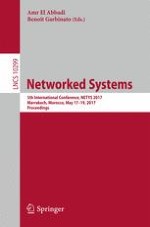This book constitutes the thoroughly refereed conference proceedings of the 5th International Conference on Networked Systems, NETYS 2017, held in Marrakech, Morocco, in May 2017.
The 28 full and 6 short papers presented together with 3 keynotes were carefully reviewed and selected from 81 submissions. They are organized around the following topics: networking; distributed algorithms; atomicity; security and privacy; software engineering; concurrency and specifications; policies; agreement and consensus; clustering based techniques; verification; communication.
